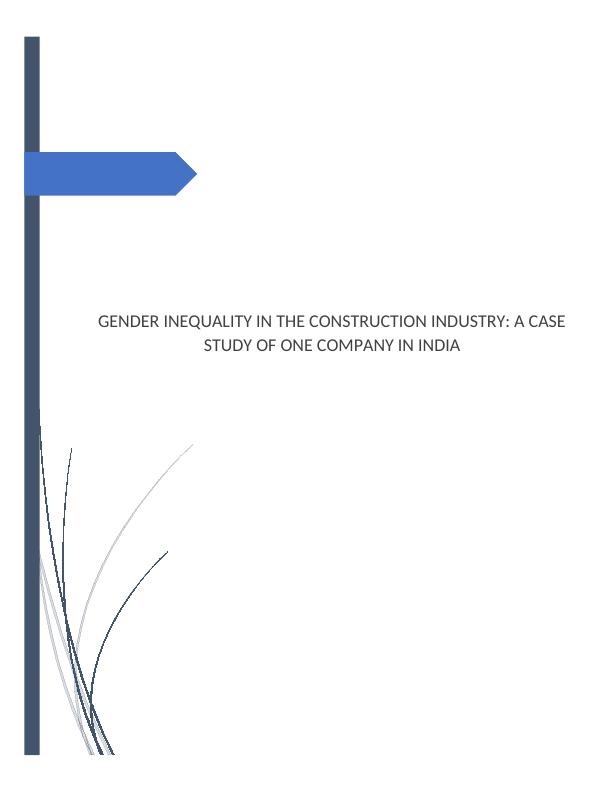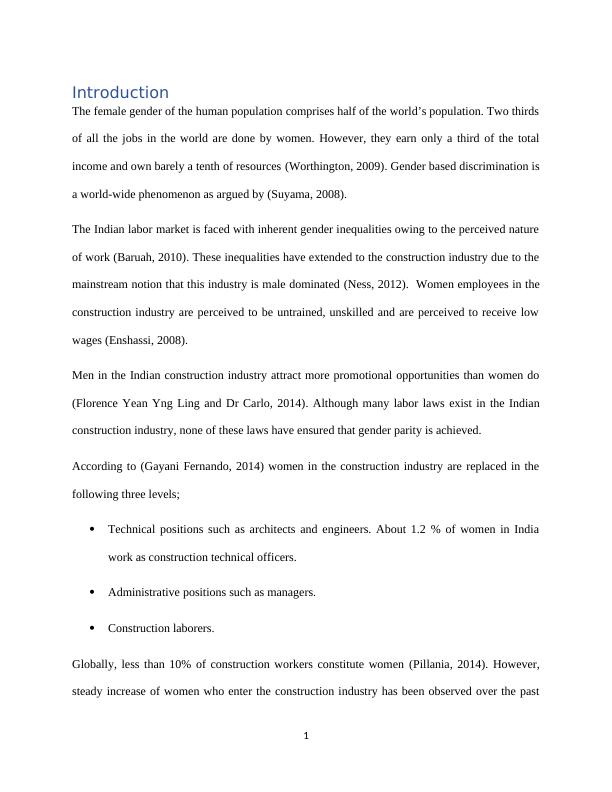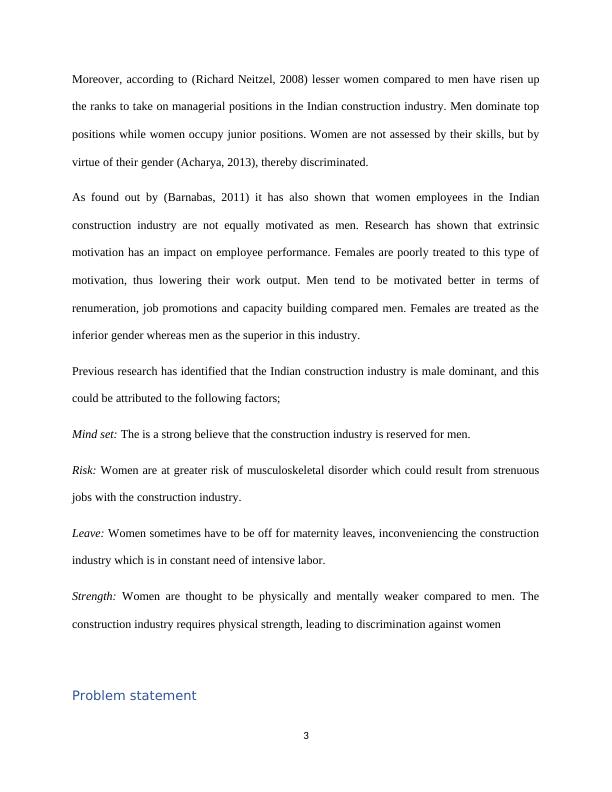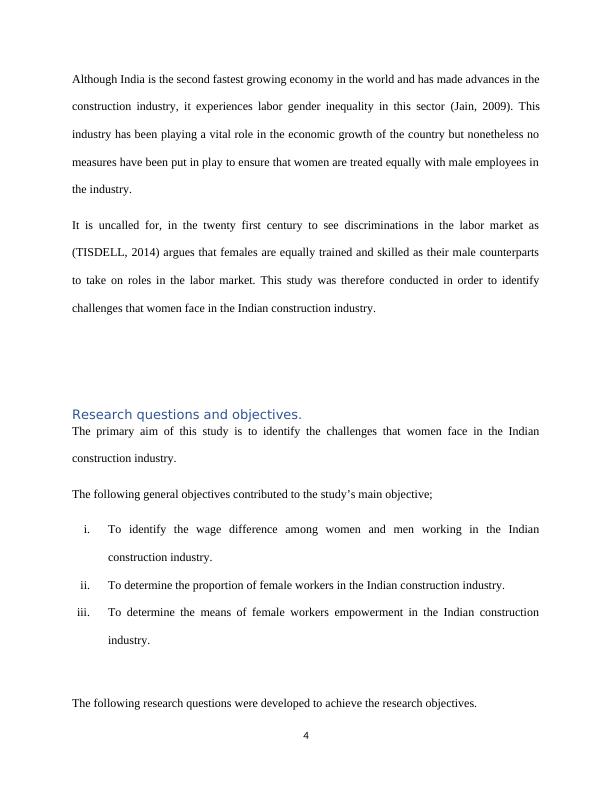Gender Inequality in the Construction Industry: A Case Study of One Company in India
Added on 2023-05-31
21 Pages3667 Words108 Views
GENDER INEQUALITY IN THE CONSTRUCTION INDUSTRY: A CASE
STUDY OF ONE COMPANY IN INDIA
STUDY OF ONE COMPANY IN INDIA

Table of Contents
Introduction.................................................................................................................................................1
Problem statement..................................................................................................................................4
Research questions and objectives..........................................................................................................4
Hypotheses..............................................................................................................................................5
Research Methodology................................................................................................................................6
Study design............................................................................................................................................6
Data collection.........................................................................................................................................6
Data analysis............................................................................................................................................6
Results.........................................................................................................................................................7
Descriptive statistics................................................................................................................................7
Wages..................................................................................................................................................7
Motivation...........................................................................................................................................8
Cross tabulation.......................................................................................................................................9
Inferential statistics...............................................................................................................................10
Correlation analysis...........................................................................................................................10
Regression analysis............................................................................................................................11
Discussion..................................................................................................................................................13
Conclusion, Limitations and Recommendations........................................................................................13
Conclusion.............................................................................................................................................13
Limitations.............................................................................................................................................14
Recommendations.................................................................................................................................14
References.................................................................................................................................................16
Appendix...................................................................................................................................................18
1
Introduction.................................................................................................................................................1
Problem statement..................................................................................................................................4
Research questions and objectives..........................................................................................................4
Hypotheses..............................................................................................................................................5
Research Methodology................................................................................................................................6
Study design............................................................................................................................................6
Data collection.........................................................................................................................................6
Data analysis............................................................................................................................................6
Results.........................................................................................................................................................7
Descriptive statistics................................................................................................................................7
Wages..................................................................................................................................................7
Motivation...........................................................................................................................................8
Cross tabulation.......................................................................................................................................9
Inferential statistics...............................................................................................................................10
Correlation analysis...........................................................................................................................10
Regression analysis............................................................................................................................11
Discussion..................................................................................................................................................13
Conclusion, Limitations and Recommendations........................................................................................13
Conclusion.............................................................................................................................................13
Limitations.............................................................................................................................................14
Recommendations.................................................................................................................................14
References.................................................................................................................................................16
Appendix...................................................................................................................................................18
1

Introduction
The female gender of the human population comprises half of the world’s population. Two thirds
of all the jobs in the world are done by women. However, they earn only a third of the total
income and own barely a tenth of resources (Worthington, 2009). Gender based discrimination is
a world-wide phenomenon as argued by (Suyama, 2008).
The Indian labor market is faced with inherent gender inequalities owing to the perceived nature
of work (Baruah, 2010). These inequalities have extended to the construction industry due to the
mainstream notion that this industry is male dominated (Ness, 2012). Women employees in the
construction industry are perceived to be untrained, unskilled and are perceived to receive low
wages (Enshassi, 2008).
Men in the Indian construction industry attract more promotional opportunities than women do
(Florence Yean Yng Ling and Dr Carlo, 2014). Although many labor laws exist in the Indian
construction industry, none of these laws have ensured that gender parity is achieved.
According to (Gayani Fernando, 2014) women in the construction industry are replaced in the
following three levels;
Technical positions such as architects and engineers. About 1.2 % of women in India
work as construction technical officers.
Administrative positions such as managers.
Construction laborers.
Globally, less than 10% of construction workers constitute women (Pillania, 2014). However,
steady increase of women who enter the construction industry has been observed over the past
1
The female gender of the human population comprises half of the world’s population. Two thirds
of all the jobs in the world are done by women. However, they earn only a third of the total
income and own barely a tenth of resources (Worthington, 2009). Gender based discrimination is
a world-wide phenomenon as argued by (Suyama, 2008).
The Indian labor market is faced with inherent gender inequalities owing to the perceived nature
of work (Baruah, 2010). These inequalities have extended to the construction industry due to the
mainstream notion that this industry is male dominated (Ness, 2012). Women employees in the
construction industry are perceived to be untrained, unskilled and are perceived to receive low
wages (Enshassi, 2008).
Men in the Indian construction industry attract more promotional opportunities than women do
(Florence Yean Yng Ling and Dr Carlo, 2014). Although many labor laws exist in the Indian
construction industry, none of these laws have ensured that gender parity is achieved.
According to (Gayani Fernando, 2014) women in the construction industry are replaced in the
following three levels;
Technical positions such as architects and engineers. About 1.2 % of women in India
work as construction technical officers.
Administrative positions such as managers.
Construction laborers.
Globally, less than 10% of construction workers constitute women (Pillania, 2014). However,
steady increase of women who enter the construction industry has been observed over the past
1

decade. Demand has for construction workers has equally gone high. Women therefore find it
easier to find jobs in the construction industry (Lingard, 2004). This state of affairs is observed in
the Indian construction industry.
In the twenty first century, equality is a norm that should be observed in every sector of
economy. The Indian construction industry should bring more women on board with the rising
demand for construction workers (BISHWANATH GOLDAR, 2012) as more women are
training for jobs in the construction industry.
(Proctor, 2012) has shown that the numbers between male and female in classrooms training for
jobs in the construction industry is beginning to equal out.
However, there is limited information on women employees’ welfare in the Indian construction
industry.
In India, various empirical studies have shown that women face lots of challenges in the
construction industry (Mathew, 2005). According to the Occupational Safety and Health
administration research done in 1999, it was shown that 88 % women in the Indian construction
industry face sexual harassment.
Other than sexual harassment, there exist other challenges that women face in the Indian
construction industry as outlined by (Lakhani, 2004). Discrimination on basic amenities such as
bathrooms is one such challenge.
Another challenge faced by women construction workers in the Indian construction industry is
inequality concerning renumeration compared to their male counterparts (Choudhury, 2013).
Females construction workers were found out to be paid much less compared to male
construction workers (Deininger, 2013).
2
easier to find jobs in the construction industry (Lingard, 2004). This state of affairs is observed in
the Indian construction industry.
In the twenty first century, equality is a norm that should be observed in every sector of
economy. The Indian construction industry should bring more women on board with the rising
demand for construction workers (BISHWANATH GOLDAR, 2012) as more women are
training for jobs in the construction industry.
(Proctor, 2012) has shown that the numbers between male and female in classrooms training for
jobs in the construction industry is beginning to equal out.
However, there is limited information on women employees’ welfare in the Indian construction
industry.
In India, various empirical studies have shown that women face lots of challenges in the
construction industry (Mathew, 2005). According to the Occupational Safety and Health
administration research done in 1999, it was shown that 88 % women in the Indian construction
industry face sexual harassment.
Other than sexual harassment, there exist other challenges that women face in the Indian
construction industry as outlined by (Lakhani, 2004). Discrimination on basic amenities such as
bathrooms is one such challenge.
Another challenge faced by women construction workers in the Indian construction industry is
inequality concerning renumeration compared to their male counterparts (Choudhury, 2013).
Females construction workers were found out to be paid much less compared to male
construction workers (Deininger, 2013).
2

Moreover, according to (Richard Neitzel, 2008) lesser women compared to men have risen up
the ranks to take on managerial positions in the Indian construction industry. Men dominate top
positions while women occupy junior positions. Women are not assessed by their skills, but by
virtue of their gender (Acharya, 2013), thereby discriminated.
As found out by (Barnabas, 2011) it has also shown that women employees in the Indian
construction industry are not equally motivated as men. Research has shown that extrinsic
motivation has an impact on employee performance. Females are poorly treated to this type of
motivation, thus lowering their work output. Men tend to be motivated better in terms of
renumeration, job promotions and capacity building compared men. Females are treated as the
inferior gender whereas men as the superior in this industry.
Previous research has identified that the Indian construction industry is male dominant, and this
could be attributed to the following factors;
Mind set: The is a strong believe that the construction industry is reserved for men.
Risk: Women are at greater risk of musculoskeletal disorder which could result from strenuous
jobs with the construction industry.
Leave: Women sometimes have to be off for maternity leaves, inconveniencing the construction
industry which is in constant need of intensive labor.
Strength: Women are thought to be physically and mentally weaker compared to men. The
construction industry requires physical strength, leading to discrimination against women
Problem statement
3
the ranks to take on managerial positions in the Indian construction industry. Men dominate top
positions while women occupy junior positions. Women are not assessed by their skills, but by
virtue of their gender (Acharya, 2013), thereby discriminated.
As found out by (Barnabas, 2011) it has also shown that women employees in the Indian
construction industry are not equally motivated as men. Research has shown that extrinsic
motivation has an impact on employee performance. Females are poorly treated to this type of
motivation, thus lowering their work output. Men tend to be motivated better in terms of
renumeration, job promotions and capacity building compared men. Females are treated as the
inferior gender whereas men as the superior in this industry.
Previous research has identified that the Indian construction industry is male dominant, and this
could be attributed to the following factors;
Mind set: The is a strong believe that the construction industry is reserved for men.
Risk: Women are at greater risk of musculoskeletal disorder which could result from strenuous
jobs with the construction industry.
Leave: Women sometimes have to be off for maternity leaves, inconveniencing the construction
industry which is in constant need of intensive labor.
Strength: Women are thought to be physically and mentally weaker compared to men. The
construction industry requires physical strength, leading to discrimination against women
Problem statement
3

Although India is the second fastest growing economy in the world and has made advances in the
construction industry, it experiences labor gender inequality in this sector (Jain, 2009). This
industry has been playing a vital role in the economic growth of the country but nonetheless no
measures have been put in play to ensure that women are treated equally with male employees in
the industry.
It is uncalled for, in the twenty first century to see discriminations in the labor market as
(TISDELL, 2014) argues that females are equally trained and skilled as their male counterparts
to take on roles in the labor market. This study was therefore conducted in order to identify
challenges that women face in the Indian construction industry.
Research questions and objectives.
The primary aim of this study is to identify the challenges that women face in the Indian
construction industry.
The following general objectives contributed to the study’s main objective;
i. To identify the wage difference among women and men working in the Indian
construction industry.
ii. To determine the proportion of female workers in the Indian construction industry.
iii. To determine the means of female workers empowerment in the Indian construction
industry.
The following research questions were developed to achieve the research objectives.
4
construction industry, it experiences labor gender inequality in this sector (Jain, 2009). This
industry has been playing a vital role in the economic growth of the country but nonetheless no
measures have been put in play to ensure that women are treated equally with male employees in
the industry.
It is uncalled for, in the twenty first century to see discriminations in the labor market as
(TISDELL, 2014) argues that females are equally trained and skilled as their male counterparts
to take on roles in the labor market. This study was therefore conducted in order to identify
challenges that women face in the Indian construction industry.
Research questions and objectives.
The primary aim of this study is to identify the challenges that women face in the Indian
construction industry.
The following general objectives contributed to the study’s main objective;
i. To identify the wage difference among women and men working in the Indian
construction industry.
ii. To determine the proportion of female workers in the Indian construction industry.
iii. To determine the means of female workers empowerment in the Indian construction
industry.
The following research questions were developed to achieve the research objectives.
4

End of preview
Want to access all the pages? Upload your documents or become a member.
Related Documents
Protection and Wellbeing Issues among Female Building Workforcelg...
|7
|1485
|49
Gender Equality, Discrimination, and Issues: Contemporary Challengeslg...
|27
|2310
|291
Gender Inequality and Solutions for Women Empowerment in Society and Workplacelg...
|7
|1346
|487
Women and Workplace Discrimination in Australian Organizationslg...
|17
|4508
|90
Impact of Gender on Workplace Discrimination in the US Construction Industrylg...
|21
|3877
|459
Managing Human Resources : Assignmentlg...
|10
|2787
|59